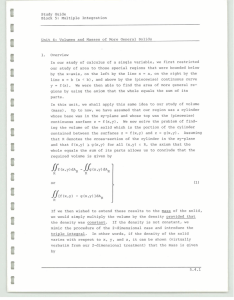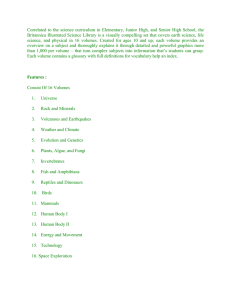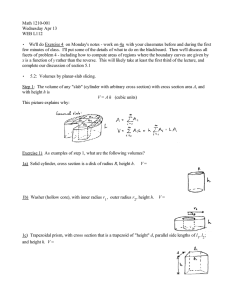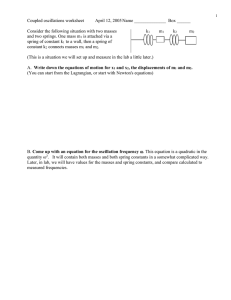Document 13650798
advertisement
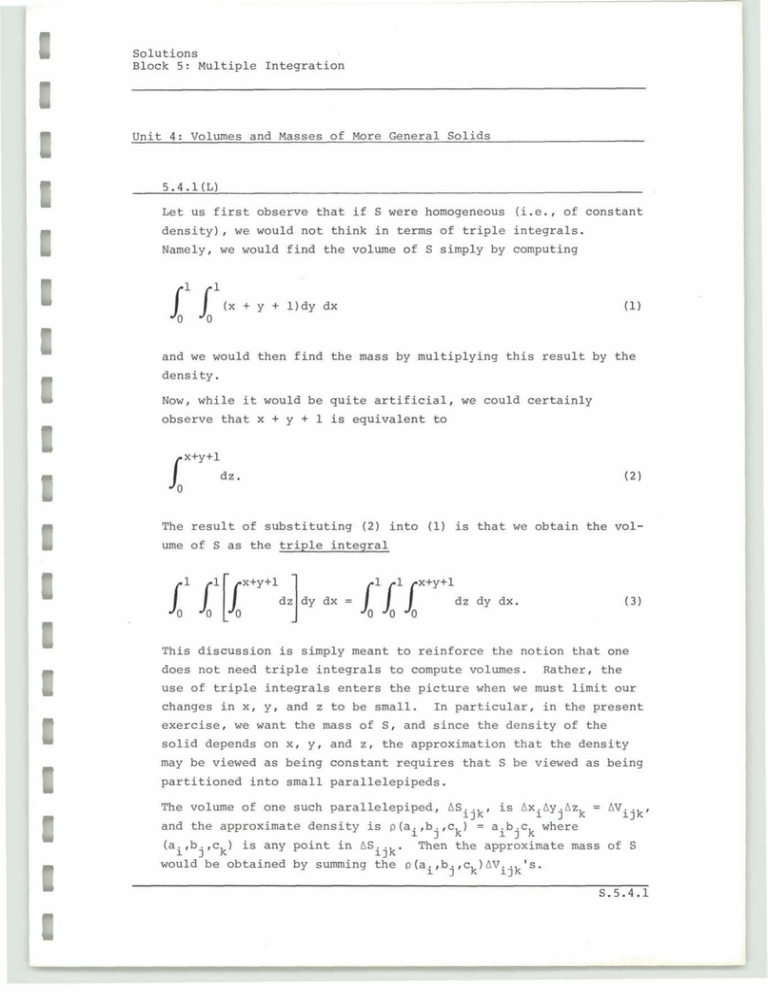
Solutions Block 5: Multiple Integration Unit 4: Volumes and Masses of More General Solids 5.4.1(L) Let us first observe that if S were homogeneous (i.e., of constant density), we would not think in terms of triple integrals. Namely, we would find the volume of S simply by computing and we would then find the mass by multiplying this result by the density. Now, while it would be quite artificial, we could certainly observe that x + y + 1 is equivalent to
The result of substituting (2) into (1) is that we obtain the vol- ume of S as the triple integral dz dy dx. This discussion is simply meant to reinforce the notion that one does not need triple integrals to compute volumes. Rather, the use of triple integrals enters the picture when we must limit our changes in x, y, and z to be small. In particular, in the present exercise, we want the mass of S, and since the density of the solid depends on x, y, and z, the approximation that the density may be viewed as being constant requires that S be viewed as being partitioned into small parallelepipeds. The volume of one such parallelepiped, ASijk, is Ax.Ay.Azk = AVijk,
1 1
and the approximate density is p(ai,b.,ck) = a.b.c where
I
1 1 k (ai,b.,c ) is any point in ASijk. Then the approximate mass of S
I k would be obtained by summing the p(ai,bj,ck)AVijk's. Solutions Block 5: Multiple Integration Unit 4: Volumes and Masses of More General Solids 5.4.1 (L) continued m fact, if we assume that gijk is the minimum density in ASijk
is the maximum density in AS
and that
ijk' then the mass M of
the solid S is bounded by
Fijk
If we let the size of the partitions approach 0 and if p(x,y,z) is continuous, we see that {kxx4jk~~ijk
m
n
,
etc.
k=l j=l i=l
Notice that our discussion here is equivalent to our discussion in Unit 1, except that we are now involved with triple sums rather than double sums. If the limit in (4) exists, we write it as and this, in turn, may be viewed as an iterated integral.
terms of the present exercise, (5) becomes In [Notice that we obtain the limits of integration just as we did in
double integration. Namely, for a fixed (x,y), z varies from the
xy-plane (z = 0) to the plane z = x + y + 1, etc.1
The key point is that while the triple integral in ( 3 ) is artificial, the triple integral in (6) is essential since the integrand is affected by a change in z.
Solutions Block 5: Multiple Integration Unit 4: Volumes and Masses of More General Solids 5.4.1 (L) continued At any rate, the actual mechanics work exactly as they did with double integrals and we obtain Solutions Block 5: Multiple Integration Unit 4: Volumes and Masses of More General Solids The key point here is that we use the axiom that the whole equals the sum of its parts. Specifically, we first compute which denotes the volume of the portion of the cylinder between
the xy-plane and z = x2 + y2 + 3 .
Then we compute which denotes the volume of the portion of the cylinder between
the xy-plane and z = x + y + 1.
Consequently, must represent the required volume since the required volume is of
the solid consisting of the portion of the cylinder between the
xy-plane and z = x2 + y2 + 3 , with t h e p o r t i o n between the xyplane and z = x + y + 1 deleted.
At any rate, since R is given by Solutions Block 5: Multiple Integration Unit 4: Volumes and Masses of More General Solids 5.4.2 (L) continued we have, i4ldY (x2
+
y2
x
-
y
+
2)dx d y *
Thus, the required volume is * R e c a l l , once a g a i n , t h a t o u r l i m i t s of i n t e g r a t i o n a r e determined
by R n o t by t h e i n t e g r a n d .
We elected to w r i t e the integral i n
t h e o r d e r d x dy r a t h e r t h a n dy d x t o s i m p l i f y t h e l i m i t s o f i n t e gration.
T h a t i s , ( 4 ) g i v e s u s 0 a s t h e l o w e r l i m i t on e a c h i n t e gral.
Had we u s e d t h e o r d e r d y d x , ( 4 ) w o u l d h a v e b e e n r e p l a c e d b y
Obviously,
integral.
t h e c o r r e c t answer s h o u l d b e o b t a i n e d from e i t h e r
Solutions
Block 5 : M u l t i p l e I n t e g r a t i o n
U n i t 4: Volumes and Masses of More General S o l i d s
5.4.2 (L) c o n t i n u e d
N o t i c e a g a i n t h a t t h e r e was no need t o u s e t r i p l e i n t e g r a l s even
though ( 4 ) c o u l d have been w r i t t e n a s
[kx2+y2-x-y+2
I
dz dx dy.
2
x + y 2 + 3 always
A l g e b r a i c a l l y , t h i s means t h a t f o r each
AS a f i n a l n o t e , w e need o n l y check t h a t z =
l i e s above z = x + y + 1.
2
( x . y ) , ( X + y 2 + 3) > (x + y + 1 ) .
Solutions Block 5: Multiple Integration Unit 4: Volumes and Masses of More General Solids 5.4.2 (L) continued Now But Hence, the surface z
z = x + y + l .
=
x 2 + y2
+ 3 always lies above the surface
For a fixed (x,y), z ranges from 0 to x2 + y2
mass of S is given by
444GLx2+y2+3
2 xyz
XYZ dz dx dy
dx dy
z=O =
=
+ 3. Hence, the
Solutions Block 5: Multiple Integration Unit 4: Volumes and Masses of More General Solids 5.4.3 continued Therefore, G~X'+Y~+~
xyz dz dx dy
=
The main twist to this exercise is that we are not explicitly
given the cylinder which is sliced by the two surfaces. In
problems like this, the technique is to eliminate z from the two
equations of the surfaces. Quite in general, if z = ft(x,y) dedenotes the bottom surface,
notes the top surface and z = fb (x,y)
then we may equate the two expressions for z to obtain Solutions Block 5: Multiple Integration Unit 4: Volumes and Masses of More General Solids 5.4.4(L) continued At first glance, it might appear that equation (1) gives the curve of intersection between the two surfaces. A second glance at equation (I), however, should soon convince us that this, in general, is not the case. In particular, notice that equation (1) can be put into the form where g = ft - fb, and the equation g(x,y) = 0 is the equation of
a curve in the xy-plane (or at least in a plane parallel to the
xy-plane), while in general the curve of intersection of two surfaces will not lie in this plane.
In fact, if we recall that the equation of a cylinder looks like
the equation of a curve in the xy-plane,* we soon suspect that
equation (2) yields the cylinder which contains the intersection
of the surfaces z = ft(x,y) and z = fb(x,y).
More specifically, denotes the set of points (x,y) which have the same z-value so
that this set may be viewed as the projection of the curve of
intersection onto the xy-plane. [Figure 16.13 and the subsequent
discussion in Thomas, Section 16.5, illustrates this point very
nicely. 1
At any rate, with respect to the given surfaces in these exercises, we obtain *For e x a m p l e , x
2
+
-
1 = 0 i s t h e c i r c l e c e n t e r e d a t (0,O) w i t h
r a d i u s 1 when we v i e w t h e e q u a t i o n i n t h e f o r m I ( x , y ) : x 2 + y 2 - 1
= 0 1 , b u t i t i s t h e r i g h t c i r c u l a r c y l i n d e r when v i e w e d i n t h e
2
2
form ( ( x , y , z ) : x + y
- 1 = 0).
y2
Solutions Block 5: Multiple Integration Unit 4: Volumes and Masses of More General Solids 5 . 4 . 4 ( L ) continued
Hence, the curve of intersection projects onto the circle
x2 + y2 = 1 in the xy-plane.
In still other words, the given solid is the portion of the cylinder x 2 + y2 = 1 between z = x2 + y2 and z = )(x2
+ y2 + 1).
To find which is the top surface and which is the bottom, we pick
a point in the projected region of the xy-plane and see which
curve is the upper curve above that point. For example, (0,O) is
in the region x2 + y2 = 1. Then the corresponding point on
2
1 (x2
+ y2 + 1) it is (O,OIT).
z = x + y2 is (0,0,0), while on )
Thus, at least above the point (0.0) z = $(x2
upper surface.
+ y2 + 1) is the
We then observe that wherever the curves interchange positions,
this will be reflected by the fact that the projection of the
curve of intersection will contain a curve corresponding to where
the surfaces crossed. In this example, the fact that the projection of the curve'of intersection in the xy-plane is the circle
x2 + y2 = 1 insures that whichever surface was the top surface at
one point inside the circle is the top surface at all points inside the circle. The circle, itself, represents the x and y coordinates of those points at which the two surfaces intersect
(i.e., at those points neither surface is higher than the other).
Finally, at those points outside the circle, the surface
2
z = x + y2 lies above the surface z = f (x2 + y2 + 1). Again. as
a check. pick, for example, the point (1,l) which lies outside
2
the circle. The corresponding point on z = x + y2 is (1.1.2)
3
while the corresponding point of z = $(x2 + y2 + 1) is (1,lf7).
The fact that the surfaces do ndt again interchange positions is
reflected by the fact that the projection of the curve of inter2
section includes nothing besides the circle x2 + y = 1.
Returning to the given problem, we seek the volume of that portion 2
2
of the cylinder x + y2 = 1 bounded below by z = x + y2 and above
1 2
by z = T(x + y2 + 1).
Solutions
Block 5: M u l t i p l e I n t e g r a t i o n
U n i t 4 : Volumes and Masses of More G e n e r a l S o l i d s
5.4.4(L) continued
Thus, t h e r e q u i r e d volume i s
where R i s :
T h e r e f o r e t h e volume i s
To e v a l u a t e (1) we o b s e r v e t h a t i t i s i n o u r b e s t i n t e r e s t s t o u s e p o l a r c o o r d i n a t e s , n o t i n g t h a t R i s simply ( ( r , B ) : O<
1-
---
rc 1, 0 < 8 < 2
-
Thus
-2
;(x2+ y )
3)
1
-
.
Moreover, o u r i n t e g r a n d becomes r 2 and o u r e l e m e n t of a r e a i s
-*;
=
Solutions
Block 5: M u l t i p l e I n t e g r a t i o n
U n i t 4: Volumes and Masses of More G e n e r a l S o l i d s
5 . 4 . 4 (L) c o n t i n u e d
5.4.5
E l i m i n a t i n g z from x
2
+
y
2
+
z2 = 4 and
z = x 2+ y2 w e o b t a i n
Hence,
r e p r e s e n t s t h e p r o j e c t i o n of t h e c u r v e of i n t e r s e c t i o n i n t o t h e
xy-plane.
Equation (1) may be s i m p l i f i e d by a s w i t c h t o p o l a r c o o r d i n a t e s
since we then obtain
Solutions
Block 5: M u l t i p l e I n t e g r a t i o n
U n i t 4 : Volumes and Masses of More General S o l i d s
5.4.4 (L) c o n t i n u e d
2
S i n c e r + 4 # 0 , e q u a t i o n ( 2 ) t e l l s u s t h a t t h e c y l i n d e r which
2
c o n t a i n s t h e c u r v e of i n t e r s e c t i o n i s r - 2 = 0 o r r = 0
.
I n o t h e r words, t h e c u r v e of i n t e r s e c t i o n p r o j e c t s o n t o t h e c i r c l e
i n t h e xy-plane c e n t e r e d a t (0,O) w i t h r a d i u s 2.
So t h e r e q u i r e d volume i s g i v e n by
where R i s t h e r e g i o n x
2
+
y2 < 2; o r
Solutions
Block 5: M u l t i p l e I n t e g r a t i o n
U n i t 4: Volumes and Masses of More General S o l i d s
5 . 4 . 4 (L) c o n t i n u e d
5.4.6
The c y l i n d e r which c o n t a i n s t h e c u r v e o f i n t e r s e c t i o n i s o b t a i n e d
from t h e equation
which is the ellipse whose semi-axes are 3 and 1.
That is
S
utions
- -o-l .
Block 5: M u l t i p l e I n t e g r a t i o n
U n i t 4 : Volumes and Masses of More General S o l i d s
- - - -
5.4.6
continued
Looking a t ( 0 . 0 ) w e s e e t h a t it corresponds t o t h e p o i n t (0.0.0)
2
on t h e s u r f a c e z = x + gy2 and t o t h e p o i n t ( 0 , 0 , 1 8 ) on t h e
2
2
2
Hence, z = 18 - x - g y 2 is t h e t o p
9y
s u r f a c e z = 18 - x
-
s u r f a c e t h r o u g h o u t R.
.
Consequently, t h e r e q u i r e d volume i s g i v e n
The i n t e g r a l i n (1) s u g g e s t s t r i g o n o m e t r i c s u b s t i t u t i o n .
3 sin 8 = x
3 c o s 8 d0 = dx
J9
- x2
= 3 cos 8
Namely,
Solutions
Block 5: M u l t i p l e I n t e g r a t i o n
U n i t 4 : Volumes and Masses of More G e n e r a l S o l i d s
-
5.4.6
continued
Theref o r e ,
a
2
s i n 8 ) 3 cos 8
[18 c o s 8
-
2
3(9
(18 c o s 8
-
1 8 s i n2 8 c o s 8
-
6
n(3
3
cos 8 ) 13 cos 8 d8
n
= 61;
-
-
6 c o s 3 8 ) c o s 8 d8
a
= 7 2 1 '[3
-
2
2
c o s 8 (1 - s i n 8 )
1 + c o s 28 2
I
-
4
cos 8ld8
Solutions
Block 5: M u l t i p l e I n t e g r a t i o n
U n i t 4 : Volumes and Masses of More General S o l i d s
5.4.6
continued
Tr
= 36 / d T ( l
= 36
1
+
+
2 c o s 28
c o s 2 28)dQ
+
2 cos 28
+
1+ 2
COS 4 9 dQ
+
4 c o s 28
+
c o s 48) d8
7r = 18 L T ( 3
= 1 8 [38
+2
s i n 28
1
+ --sin
4
48
Note : Given where R was t h e r e g i o n { ( x , y ) :
+
2
y < 11, i t might have been
a b i t s i m p l e r c o m p u t a t i o n a l l y t o make t h e change of v a r i a b l e s
In t h i s case
and o u r t r a n s f o r m e d i n t e g r a l would be
Solutions Block 5: Multiple Integration Unit 4: Volumes and Masses of More General Solids 5.4.6
continued sin 8 =
cos e =
cos ede
Solutions
Block 5: M u l t i p l e I n t e g r a t i o n
U n i t 4: Volumes and Masses of More ' ~ e n e r a lS o l i d s
5.4.6
continued Hence, which a g r e e s w i t h e q u a t i o n ( 2
.
While t h i s may n o t have been a b i g improvement over o u r o r i g i n a l
approach it does i n d i c a t e how a change of v a r i a b l e s can s i m p l i f y
t h e a r i t h m e t i c i n v o l v e d i n computing a double i n t e g r a l .
W e may view t h e s o l i d a s b e i n g t h e p o r t i o n of t h e c y l i n d e r
2
2
( i . e . , t h e upper
x + y = a 2 bounded above by z = +
2
2
p o r t i o n of x + z2 = a ) and below by z = -
m.
Hence, l e t t i n g R
volume i s
= {
(x, y ) :x2+ y 2 1 c a2
we have t h a t t h e g i v e n
Solutions
B l o c k 5: M u l t i p l e I n t e g r a t i o n
U n i t 4: Volumes and Masses o f More G e n e r a l S o l i d s
5.4.7
continued
MIT OpenCourseWare
http://ocw.mit.edu
Resource: Calculus Revisited: Multivariable Calculus
Prof. Herbert Gross
The following may not correspond to a particular course on MIT OpenCourseWare, but has been
provided by the author as an individual learning resource.
For information about citing these materials or our Terms of Use, visit: http://ocw.mit.edu/terms.
